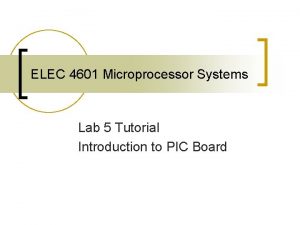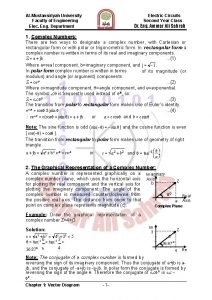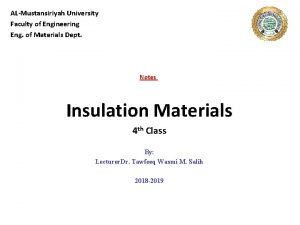AlMustansiriyah University Faculty of Engineering Elec Eng Department





- Slides: 5

Al-Mustansiriyah University Faculty of Engineering Elec. Eng. Department Electric Circuits Second Year Class Dr. Eng. Ammar Ali Sahrab 1. Thèvenin & Norton Equivalent Circuit: Thevenin’s theorem states that a linear two-terminal circuit can be replaced by an equivalent circuit consisting of a voltage source VTh in series with a impedance ZTh, where VTh is the open-circuit voltage at the terminals and ZTh is the input or equivalent impedance at the terminals when the independent sources are turned off. Norton’s theorem states that a linear two-terminal circuit can be replaced by an equivalent circuit consisting of a current source IN in parallel with impedance ZN, where IN is the short-circuit current through the terminals and ZN is the input or equivalent impedance at the terminals when the independent sources are turned off. Thèvenin & Norton equivalents are circuit simplification techniques that focus on terminal behavior. Thèvenin & Norton equivalent circuits are used to represent any circuit made up of linear elements. In circuit analysis we want to replace the circuit between terminals a & b by an equivalent voltage or current source with internal impedance. Zth a Vth a Equivalent Thèvenin Circuit IN b ZN Equivalent Norton Circuit b Note: When computing Zth or Z N the independent voltage sources are short circuited and independent current sources are open circuited. Example: Find the equivalent Thèvenin & Norton circuits between terminals a & b in the circuit shown. Solution: Using voltage divider rule. Vth 10 0 O 3 j 4 5 j 2. 5 5. 59 26. 6 O V 5 3 j 4 5 (3 j 4) Z th Z N j 5 2. 5 j 6. 25 5 3 j 4 6. 732 68. 2 O 5 V 3 j 4 10 0 O Z P 4. 152 48. 4 O V 5 ZP j 5 (3 j 4) Z (0. 833 where P j 2. 5) j 5 3 j 4 4. 152 48. 4 O V O I N 3 j 4 0. 621 j 0. 552 0. 831 41. 6 A j 5 Chapter 2: Thevenin & Norton -10 - 10 0 O V j 5 3 j 4 a Vth b IN

Al-Mustansiriyah University Faculty of Engineering Elec. Eng. Department Electric Circuits Second Year Class Dr. Eng. Ammar Ali Sahrab Example: Find the Thèvenin & Norton equivalent circuits with respect to the terminals a & b for the circuit shown. Solution: 72 V Vth V 20 V 8 (12 8) 5 and ZP 4 (12 8) 5 8 20 ZP V 60 4. 8 64. 8 V Vth 5 20 Z'P 4 5 20 ' 12 (8 Z ) Z th Z N P ' 6 12 8 Z P 20 ) I T VT 72 12. 72 A ZT 5. 66 12 T Z''P 12 4. 8 A IN 6 4. 8 10. 8 A (I I 8 T 20 ) 12 20 8 Example: Find the Thèvenin & Norton equivalent circuits with respect to the terminals a & b for the circuit shown. Solution: 5+�� 5 �� = 5 30�� × 20+�� = 1. 58 48. 4���� 10 �� 5) = 11. 18 93. 4���� �� �� ℎ = 1. 58 48. 4 × (5 + �� 5+�� 5 = 2. 2 56. 56�� �� = 5 30�� �� 15+�� 5 �� (15+�� 5)(5+�� 5) × = 4 + �� 3 = 5 36. 87�� Ω = ���� 20+�� 10 = ℎ Another way: 5+�� 5 = 11. 18 93. 4�� × 20+�� 10 �������� ������ �� �� � 3 � � 0� � × � (� 5� � +� � 5� )� �� �� ℎ = 5� �� �� ℎ ���� = �� �� ℎ 11. 18 93. 4 �� = 5 36. 87�� 2. 2 56. 56�� �� = Chapter 2: Thevenin & Norton 8 4. 8 V 8 12 IN I 12 I 8 20 8 5 Z''P 20 8 10. 7143 '' ZT 12 ZP'' 5. 66 12 ZP Using current divider rule. Z''P I I 6 A and I 5 8 a 20 Vth b Using voltage divider rule. 20 V 72 60 V and V (72 20 12 -11 - IN


Al-Mustansiriyah University Faculty of Engineering Elec. Eng. Department Electric Circuits Second Year Class Dr. Eng. Ammar Ali Sahrab 2. Dependent Sources: An ideal dependent (or controlled) source is an active element in which the source quantity is controlled by another voltage or current. It establishes a voltage or current whose value depends on the value of a voltage or current elsewhere in the circuit. The value of a dependent source could not be specified unless knowing the value of the voltage or current on which it depends. VS VX VS I X Voltage Controlled Voltage Source IS VX Current Controlled Voltage Source Voltage Controlled Current Source IS I X Current Controlled Current Source Where: , , , & are multiplying constants; & are dimensionless, is volt per ampere dimension, and is ampere per volt dimension. Note: An active element is one that models a device capable of generating electric energy. Passive element model is physical devices that cannot generate electric energy (e. g. resistor, inductor, & capacitor). 3. Analysis of Circuit Containing Dependent Source: Think about a circuit analysis strategy before beginning to write equations, not every closed path provides an opportunity to write a useful equation based on Kirchhoff’s voltage law and Ohm’s law. Not every node provides for a useful application of Kirchhoff’s current law and Ohm’s law. Some preliminary thinking about the problem can help in selecting the most harmful approach and the most useful analysis tools for a particular problem. Choosing a good approach and the appropriate tools will usefully reduce the number and complexity of equations to be solved. Example: Find the Norton equivalent circuits with respect to the terminals a & b for the circuit shown. Solution: 6�� �� = ���� 2 ���� 6�� �� = =0�� �� �� 1 = �� 1 ∴ ���� = 10 − 45� �� ℎ − 6�� �� � = �� and �� � � 2//�� 1 �� ℎ 6�� �� � = �� �� ℎ × ��� 8�� 1 ×� �= �� 2+�� �� ℎ −�� �� ℎ × 2+�� 1 ∴ ���� ℎ 2//�� 1 �� ℎ 8�� �� �� ℎ = 2+�� 1 + �� ���� = = 1. 6 ℎ = 2+�� 1 �� �� ℎ 3. 2Ω Chapter 2: Thevenin & Norton -13 -

Al-Mustansiriyah University Faculty of Engineering Elec. Eng. Department Electric Circuits Second Year Class Dr. Eng. Ammar Ali Sahrab Example: Find the Thèvenin & Norton equivalent circuits with respect to the terminals a & b for the circuit shown. 120 V Solution: First, finding voltage source equivalent Thèvenin circuit, with 12 & 60Ω resistors. 12 60 Ze 10 12 60 Ve 120 60 100 V 60 12 j 40 120 12 60 VX a 10 VX b j 40 120 10 100 V Using Kirchhoff’s voltage law. I j 40 I 120 I VX …(1) …(2) 100 10 VX (10 j 40 120)I VX 100 10 I a 10 VX Vth b IN Substitute eq. 2 in eq. 1 to get: I 900 18 126. 87 O A Substitute in eq. 2 get: 30 j 40 VX 100 180 126. 87 O 208 V j 144 V 10 V 120 I 2080 j 1440 120 18 126. 87 O 784 j 288 th X 835. 22 20. 17 O V Using Kirchhoff’s current law. j 40 VX 100 10 j 40 I I I N j 40 O 120 8. 44 2. 66 A …(3) 100 10 j 40 10 VX 8. 314 j 0. 392 120 Using Kirchhoff’s current law. I j 40 VT 10 j 40 …(4) 12 10 …(5) VX 10 I j 40 VT 10 j 40 V V (9 j 4) …(6) I 120 T 10 VX T 120(1 j 4) VT 1 9 j 4 VT (3 j 4) IT I j 40 I 120 10 j 40 12(10 j 40) Z th VT 91. 2 j 38. 4 98. 955 22. 8 O IT VX 60 120 a 10 VX b Notes: 1. The dependent source could not be eliminated, because it depends on a voltage which is not zero. In other words its look like independent source supplies a current to the circuit. 2. When computing Zth or ZN the independent voltage sources are short circuited and the independent current sources are open circuited, while the dependent voltage and current sources are remain in the circuit. Chapter 2: Thevenin & Norton -14 - IT Vth









